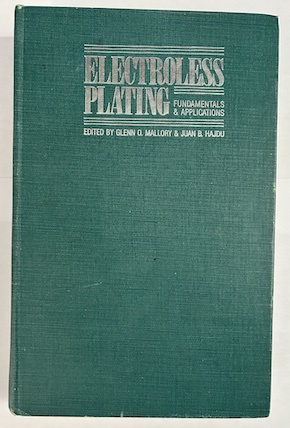
-----
Plating problem on 12L14 steel shafts
Q. I am the supplier development manager for a tier 2 Automotive supplier. We buy shafts made from 12L14 steel that are Zinc plated. We have a phenomenon in that the shafts have ground and turned diameters. The ground diameters plate well, the unground diameters exhibit flaking and dark deposits.
Any insights
automotive - Elkhart, Indiana, USA
2006
A. C12L14 is a leaded steel. You will have to incorporate Fluoboric acid descaler in the cleaning cycle. It is the lead that is causing the problem.

Sara Michaeli
Tel-Aviv-Yafo, Israel
2006
Q. Sara,
If this is a typical scenario for 12L14 because of lead content. What explains the fact that only turned areas of the shafts are affected, ground areas are not.
- Elkhart, Indiana, USA
2006
A. Turning smears the lead more than grinding does.

Jeffrey Holmes, CEF
Spartanburg, South Carolina
2006
Q. This problem is intermittent (not all shafts) and only on turned areas of the 12L14 shaft. Would the concentration of the fluoboric acid be an issue?
Abe Verghis- Mississauga, Ontario, Canada
2006
A. I am the supplier quality manager for an OEM and we have experienced the same problems. I have done extensive root cause analysis and also contracted out to forensics labs for additional analysis. Our plater has added a hot water soak/rinse just before the chromate is applied. This helped but did not eliminate the problem. Aggressive machining will smear or create "laps" (Lamination) in the surface that entrap cleaning fluids used in the plating process. This entrapped fluid will then leach out over time creating the brown spots. Machine cutting oils rather than water soluble also increases the possibility of "brown spots". Find out what cutting fluids are used in the machining process. Most grinding operations use water soluble.
Thomas Luniewski- Mpls, Minnesota, USA
2006
Why fluoboric acid for EN plating of 12L14?
Q. Why is fluoboric acid best for pickling 12L14 before EN plating?
Doug Friend- Mattawan, Michigan
July 14, 2014
I think it's very hard to troubleshoot at 2nd hand or 3rd hand, but thread 42907, "Black/Brown stains on electroless nickel plating", offers a number of ideas and you may recognize a similar situation to yours. And Mallory & Hajdu's Electroless Plating.
suggests that patterns/streaking can be caused by poor agitation, poor surface prep, metallic contamination, surface residue, or gas patterns; and dark deposits can be caused by contaminated rinse, improper surface prep, too low pH, too low temperature, low bath activity, or organic contamination. Hopefully someone with more electroless nickel troubleshooting than I will chime in, but my first guess is poor rinsing/drying combined perhaps with too thin plating. My reason for this guess is that the worst, darkest, spots look like they are at corners/edges from which a drop of water might dangle.
Good luck!
Regards,

Ted Mooney, P.E.
Striving to live Aloha
finishing.com - Pine Beach, New Jersey
Ted is available for instant help
or longer-term assistance.
Can fluoboric acid be saturated with lead although it analyzes at 11%
Q. We use a 15% Fluoboric acid bath to activate 12L14 threaded material before we acid copper plate. We have started to see a dark appearance in the low current areas of the minor diameter of the threads. We see spots in that same area after we have cleaned and activated some samples we have pulled barrels. We then dip the parts into a copper sulphate ⇦ on eBay or Amazon [affil link] solution. We then substituted hydrochloric acid in place of the fluoboric acid and didn't see the bare areas. We are wondering if the fluoboric acid can become saturated with the lead that it has removed to the point that it won't remove any more, even through our analysis indicates that our fluoboric acid is still at 11%. We maintain good adhesion even with the bare areas.
Chris Polston. - Xenia, Ohio - United States
December 18, 2017
A. Hello Chris, I have had experience with tin - lead plating years back but the same dip was used before Sn-Pb plate. One way to tell for sure is to take a sample of a new dip and one of the aged dip. In a graduated cylinder check the specific gravity of both. You want to make sure both dips have the same concentration of fluoboric acid at the time of this comparison or your SG readings will be inconclusive. If the aged or current dip has a much higher SG then you know if there is an
problem. If you have an AA and can analyze for lead, do that. You also want to make sure you have adequate and clean rinsing before you go into the Cu.
Process Engineering - Phoenix, Arizona USA
December 21, 2017
Q, A, or Comment on THIS thread -or- Start a NEW Thread
